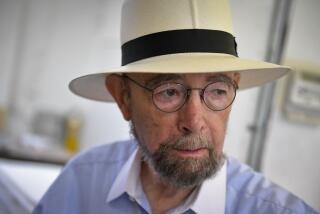Few Notice Printer Behind the Scenes
- Share via
The works of David Gardner seem to be everywhere, but still, few people notice. Instead the notoriety is left to his high-profile clients, including Brett Weston, Kenny Rogers and the late Ansel Adams.
Gardner, owner of Gardner Lithograph in Buena Park, stays behind the scenes, printing books, posters, calendars, catalogues, brochures and annual reports. His better-known printing efforts include “The Portfolios of Ansel Adams” and 17 posters of Adams’ most famous photographs.
Gardner’s entry into the photographic community dates back to 1975 when he was publishing Picture Magazine, which showcased the efforts of up-and-coming photographers. “It was a wonderful photographic magazine,” Gardner said. “It brought us to the attention of photographers all over the country.
“We could never make it pay financially. It was good self-advertising for us. It wasn’t economically viable, but it helped bring us to the attention of the photographic community.”
The magazine, which lasted for 21 issues over a period of 6 years, brought Gardner to the attention of Adams, who was very demanding about the reproduction of his work.
“Once Ansel knew it was possible to do things in a better way, there was no compromise,” Gardner said. “That was the way it had to be done. Ansel’s phrase was, ‘There is no compromise with excellence; that’s the objective of everything.’
“He had a wonderful attitude about it. He was never unreasonable in his expectations. He always understood the process. He never expected it (the reproduction) to be a perfect replica of what he gave you, but he liked to explore the possibilities of the printed media.”
Gardner, 63, was born in Texas and reared in Los Angeles. He took journalism classes at Manual Arts High School and went to college at USC. He then taught high school in El Monte and San Diego.
He taught for 5 years, then went to work as a printing salesman. He stayed with that for 4 years and in 1959 started his own printing business with Orbie Fulmer in Huntington Park. They moved the operation to Buena Park a year later. They sold the business in 1986, and Gardner bought it back in 1987 .
“I think we are quite unique among printers . . . in the world in terms of the work we do,” he said.
“We pioneered the use of the laser scanner for black-and-white work. It (the laser scanner) wasn’t made to do that, it was made to make color separations. That’s why most people buy it. But we started doing black-and-whites on it very early when we realized some of the possibilities. . . .
“One of the problems in printing black-and-white photographs is that most printers never get them black enough. If they get them black enough, the images are plugged up in the shadows so you can never see any detail.”
Gardner started experimenting with the scanner and found he could distort the tonal curve.
“We print most black-and-white work on a 285-line screen. That means there are 285 dots in each direction in an inch square,” he said. “That’s 81,225 dots in a square inch.
“Each one of those dots is composed of 144 bits of visual information. So the scanner can examine the original prints and reflect the detail it sees in a dot that is put on a film by laser beam. It can do detail a camera simply can’t do.”
Today Gardner has a lot of competition from foreign markets. “For the most part I think Japan and the Far East are cheaper, but they don’t print as well,” he said. “I’m proud of the fact that we’re better printers in this country than they are in Japan. They don’t begin to do black-and-white as well.
“As a rule, a book sells for five times the production cost, which includes the retailer’s profit, the distributor’s profit, freight costs. It’s an expensive process to get them to the marketplace.”
Gardner’s work doesn’t just include photography books. One of his largest jobs was printing 500,000 national catalogues for Mercedes-Benz of North America Inc. He delivered 100,000 a month for 5 months.
Among his other projects were the making of photographic separations for the first 18 Super Bowl programs and printing a 24-page insert for the David Hockney catalogue for the Los Angeles County Museum of Art.
His most recent books include “Odyssey,” a selection of photographs from the archives of the National Geographic Society; “Light Years,” the photographs of Morley Baer, and “Letters and Images 1916-1984,” from the correspondence and photographs of Ansel Adams.



